p.376
p.380
p.384
p.388
p.392
p.396
p.400
p.404
p.408
Nano Composite Membranes of Sulfonated Amine-Poly(ether sulfone)s and SiO2 for Fuel Cell Application
Abstract:
Organic-inorganic Nano composite membranes were prepared by Sulfonated amine-poly(ether sulfone)s (S-APES)s and SiO2. S-APESs were prepared by nitration, reduction and sulfonation of poly(ether sulfone) (ultrason®-S6010). Poly(ether sulfone) was reacted with ammonium nitrate and trifluoroacetic anhydride to produce the nitrated poly(ether sulfone), and was followed by reduction using tin(Ⅱ)chloride and sodium iodide as reducing agents to give the amino-poly(ether sulfone). The S-APES was obtained by reaction of 1,3-propanesultone and the amino-poly(ether sulfone) (NH2-PES) with sodium methoxide. The different degrees of nitration and reduction of poly(ether sulfone) were successfully synthesized by an optimized process. Organic-inorganic nano composite membranes were obtained by mixing S-APES (45 %) with hydrophilic SiO2 (20 nm, 4-10 %) obtained by sol-gel process. Different contents of SiO2 of the S-APES were studied by FT-IR, 1H-NMR spectroscopy, differential scanning calorimetry (DSC), and thermo gravimetric analysis (TGA). Sorption experiments were conducted to observe the interaction of sulfonated polymers with water and methanol. The ion exchange capacity (IEC), a measure of proton conductivity, was evaluated. The nano composite membranes exhibit conductivities (25 °C) from 3.51 x 10-3 to 4.10 x 10-3 S/cm, water swell from 57.25 to 60.50 %, IEC from 0.68 to 0.73 meq/g, and methanol diffusion coefficients from 2.81 x 10-7 to 3.33 x 10-7 cm2/S at 25 °C.
Info:
Periodical:
Pages:
392-395
Citation:
Online since:
July 2010
Price:
Сopyright:
© 2010 Trans Tech Publications Ltd. All Rights Reserved
Share:
Citation:


